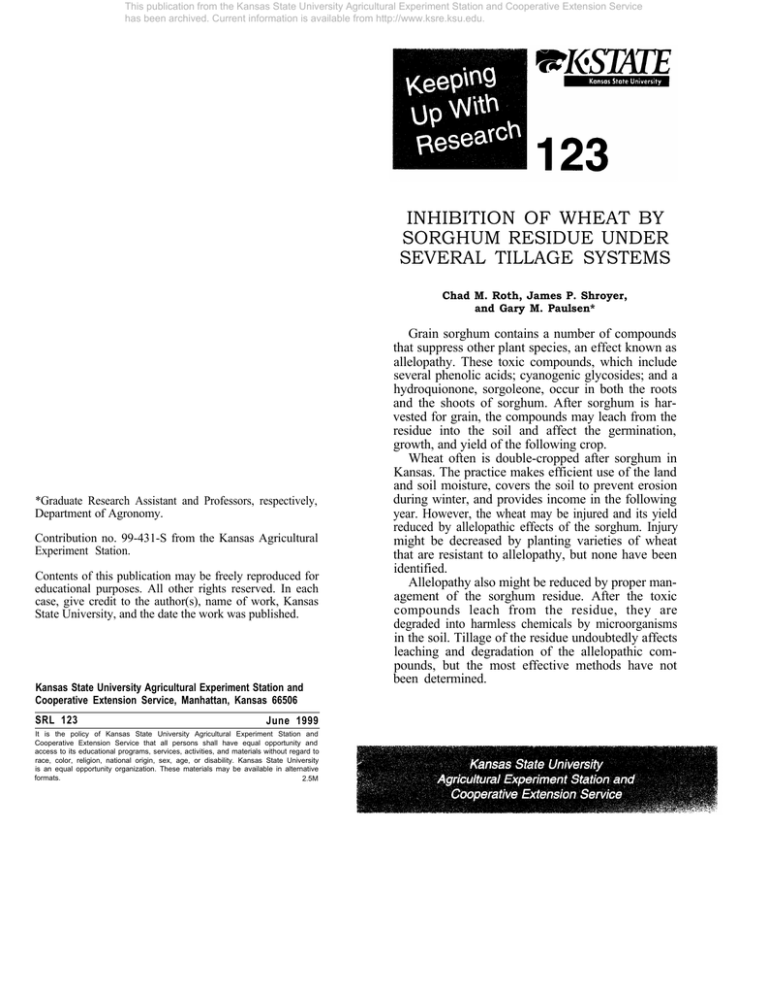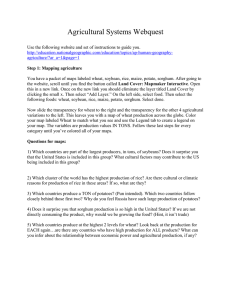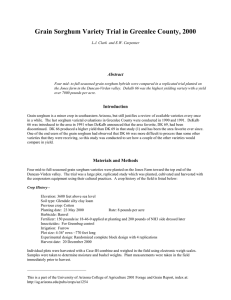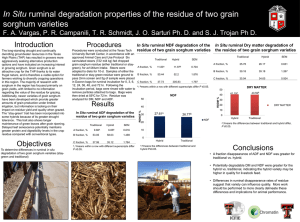
This publication from the Kansas State University Agricultural Experiment Station and Cooperative Extension Service
has been archived. Current information is available from http://www.ksre.ksu.edu.
INHIBITION OF WHEAT BY
SORGHUM RESIDUE UNDER
SEVERAL TILLAGE SYSTEMS
Chad M. Roth, James P. Shroyer,
and Gary M. Paulsen*
*Graduate Research Assistant and Professors, respectively,
Department of Agronomy.
Contribution no. 99-431-S from the Kansas Agricultural
Experiment Station.
Contents of this publication may be freely reproduced for
educational purposes. All other rights reserved. In each
case, give credit to the author(s), name of work, Kansas
State University, and the date the work was published.
Kansas State University Agricultural Experiment Station and
Cooperative Extension Service, Manhattan, Kansas 66506
SRL 123
June 1999
It is the policy of Kansas State University Agricultural Experiment Station and
Cooperative Extension Service that all persons shall have equal opportunity and
access to its educational programs, services, activities, and materials without regard to
race, color, religion, national origin, sex, age, or disability. Kansas State University
is an equal opportunity organization. These materials may be available in alternative
formats.
2.5M
Grain sorghum contains a number of compounds
that suppress other plant species, an effect known as
allelopathy. These toxic compounds, which include
several phenolic acids; cyanogenic glycosides; and a
hydroquionone, sorgoleone, occur in both the roots
and the shoots of sorghum. After sorghum is harvested for grain, the compounds may leach from the
residue into the soil and affect the germination,
growth, and yield of the following crop.
Wheat often is double-cropped after sorghum in
Kansas. The practice makes efficient use of the land
and soil moisture, covers the soil to prevent erosion
during winter, and provides income in the following
year. However, the wheat may be injured and its yield
reduced by allelopathic effects of the sorghum. Injury
might be decreased by planting varieties of wheat
that are resistant to allelopathy, but none have been
identified.
Allelopathy also might be reduced by proper management of the sorghum residue. After the toxic
compounds leach from the residue, they are
degraded into harmless chemicals by microorganisms
in the soil. Tillage of the residue undoubtedly affects
leaching and degradation of the allelopathic compounds, but the most effective methods have not
been determined.
This publication from the Kansas State University Agricultural Experiment Station and Cooperative Extension Service
has been archived. Current information is available from http://www.ksre.ksu.edu.
Information is needed to help producers avoid the
problem of allelopathy in wheat. The objectives of
these studies were to (1) ascertain the extent of allelopathic effects of sorghum on wheat, (2) identify
wheat varieties that might be resistant to allelopathy,
and (3) determine if tillage of sorghum residue affects
the severity of allelopathy.
1996
Procedures
Grain sorghum Taylor Evans Y-101G, a hybrid
that is highly allelopathic to wheat, was planted in
two blocks at the North Agronomy Research Farm in
Manhattan in early June of 1996 and 1997. A third
block was fallowed in both years, and a block of pearl
millet hybrid 79-2068 x 89-0083, a crop that is not
allelopathic to wheat, was planted in the second year
to equalize soil moisture with that in the sorghum
blocks. The sorghum and pearl millet were grown as
recommended, and the grain of both crops was harvested in early October.
One of the sorghum blocks and the fallow block
were tilled with two passes of a disc immediately after
harvest. The other sorghum block and the pearl millet block were left untilled. Nitrogen fertilizer was
applied as needed according to the soil analysis to
equalize nutrients in all the blocks. Six hard red winter wheat varieties, Coronado, Jagger, 2137, Karl 92,
Tomahawk, and Ike, and one soft red winter wheat
variety, Cardinal, were planted at 90 lbs seed/a on all
blocks in mid-October of both years and grown as
recommended.
Wheat seedlings were counted weekly after planting until emergence ceased. The results were
expressed as an emergence promptness index (EPI),
which was calculated as the sum of the number of
seedlings that emerged each week divided by the
number of weeks after planting. A high EPI indicates
that a large number of seedlings emerged rapidly; a
low EPI indicates that seedlings emerged slowly.
The wheat was harvested with a grain bundler and
threshed in July 1997 and with a plot combine in
July 1998. The test weight and moisture content
were measured with a grain analyzer, and yields were
calculated at 13.5% moisture.
The experimental design was a completely randomized strip-plot with three replications. The tillage
treatments were main plots, and the wheat varieties
were subplots. All data were analyzed by standard
procedures.
Weather conditions were favorable for sorghum
and wheat during both years. Precipitation was generally ample and well distributed for establishing and
growing the crops, and temperature was near normal
with few extremes.
Coronado Jagger
2137
Karl 92
Tomahawk Ike Cardinal
CULTIVAR
Figure 1. Emergence promptness indices of seven
wheat varieties double-cropped after fallow and
several sorghum and pearl millet residue-management treatments.
Results
Sorghum yielded 100 to 120 bu/a of grain and
produced 5600 to 6700 lbs/a of stover in both
years. Two passes with a disc in the tilled sorghum
plots incorporated approximately 80% of the residue
and left about 1200 lbs/a of stover on the soil surface when wheat was planted. The pearl millet
yielded 80 to 100 bu/a of grain in the second year
and left about the same amount of stover as the
sorghum.
Residue treatment affected the EPI of only two
wheat varieties, Coronado and 2137, in autumn
1996 (Fig. 1). Coronado emerged faster in plots that
were previously fallowed than in plots that were
planted to sorghum and tilled, and 2137 emerged
faster in fallowed plots than in no-till sorghum plots.
Emergence rates of all varieties differed among
This publication from the Kansas State University Agricultural Experiment Station and Cooperative Extension Service
has been archived. Current information is available from http://www.ksre.ksu.edu.
CULTIVAR
CULTIVAR
Figure 2. Grain yields of seven wheat varieties
double-cropped after fallow and several sorghum
and pearl millet residue-management treatments.
Figure 3. Grain test weights of seven wheat varieties double-cropped after fallow and several
sorghum and pearl millet residue-management
treatments.
residue treatments in the second season (Fig. 1). All
the varieties emerged faster in plots that were planted
to pearl millet than in plots that were planted to
sorghum and tilled. Four varieties emerged faster
after no-till sorghum, and three emerged faster after
fallow than after tilled sorghum.
Grain yields of all wheat varieties after fallow
exceeded yields after no-till sorghum in 1997, and
yields following tilled sorghum were usually intermediate (Fig. 2). Four of the varieties-Jagger, Karl 92,
Tomahawk, and Ike-responded similarly in 1998,
with higher grain yields after fallow than after no-till
sorghum. Yields of the other varieties did not differ
among the residue treatments.
Straw weights of the seven wheat varieties differed
less than the grain yields (data not shown). Tomahawk had more straw after fallow than after both
sorghum-residue treatments in 1997, and Karl 92
and Ike had more straw after fallow than after tilled
sorghum and no-till sorghum, respectively, in 1998.
Grain test weights of several wheat varieties were
lower after fallow than after some residue treatments
(Fig. 3). In 1997, Coronado had lower test weight
after fallow than after both sorghum-residue treatments, and Jagger had lower test weight after fallow
than after tilled sorghum. In 1998, Jagger and Ike
both had lowest test weights after fallow, and Jagger
also had lower test weight after tilled sorghum than
after pearl millet.
Discussion
This publication from the Kansas State University Agricultural Experiment Station and Cooperative Extension Service
has been archived. Current information is available from http://www.ksre.ksu.edu.
Favorable weather conditions and the lack of any
effect of pearl millet eliminated moisture as a factor
affecting yields, and application of nitrogen fertilizer
eliminated soil fertility. Therefore, the 10 to 25%
reductions in yields of most wheat varieties after
no-till sorghum during one or both years of the study
must be attributed to allelopathy.
Allelopathic compounds in sorghum that was tilled
and incorporated into the soil probably were solubilized rapidly and delayed emergence of most wheat
varieties. However, these compounds presumably
degraded over time, allowing the wheat varieties to
produce similar grain yields following tilled sorghum
and fallow. Although emergence was delayed by tilled
sorghum in many cases, the marked ability of wheat
to compensate for differences in seedling development probably contributed to the absence of any
effect on grain yield.
Responses of the wheat varieties to no-till sorghum
differed substantially from the responses to tilled
sorghum. The small effects of no-till sorghum on
emergence of wheat during both autumns suggested
that the allelopathic compounds were not released
immediately into the soil. However, depressed wheat
grain yields in the following summers indicated that
the allelopathic compounds had been solubilized and
leached from the sorghum stover during the winter
and spring. Yields of all seven wheat varieties were
reduced in the first year, and yields of four varieties
were reduced in the second year after no-till sorghum
compared with fallow, suggesting that they had little
resistance to the allelopathy.
Higher grain test weights of several wheat varieties
after residue than after fallow probably were due to
compensation among the different components of
grain yield. Residue apparently reduced yields by
decreasing kernel numbers, which enabled the
remaining kernels to grow larger and have higher test
weights.
Our results suggest that the effect of sorghum
residue on the following wheat crop depends in large
part on the degree of decomposition of the stover
before the wheat is planted. Prompt tillage of the
stover after harvest of the sorghum could alleviate
allelopathy by extending the duration for decomposition and, in many cases, enabling it to occur at a
more favorable soil temperature before wheat is
planted. Although it was not investigated by us, chopping the sorghum stover finely also could accelerate
decomposition. The benefits of adequate soil moisture also suggest that irrigation of dry soil could promote decomposition and lessen the allelopathic
effects of sorghum on wheat.
The advantages of practices that reduce allelopathy by sorghum must be weighed against the soil-conserving benefits of not tilling the stover. Tillage might
not be compatible with conservation compliance
plans that require specific amounts of plant residue
on the soil surface.
Conclusions
l
l
l
l
l
Allelopathy by toxic compounds in sorghum
residue may reduce grain yield of double-cropped
wheat by 10 to 25%.
Tilled sorghum residue delayed emergence of
wheat but had no allelopathic effects on grain
yields.
No-till sorghum residue did not affect emergence of
wheat but frequently reduced grain yields.
Tillage of sorghum residue to prevent allelopathic
effects on wheat might not be compatible with conservation compliance plans.
Little genetic resistance to allelopathy by sorghum
is present in popular varieties of hard red winter
wheat in Kansas.
Acknowledgements
Financial support of this work by the Finnup
Foundation and the Kansas Wheat Commission is
appreciated.






